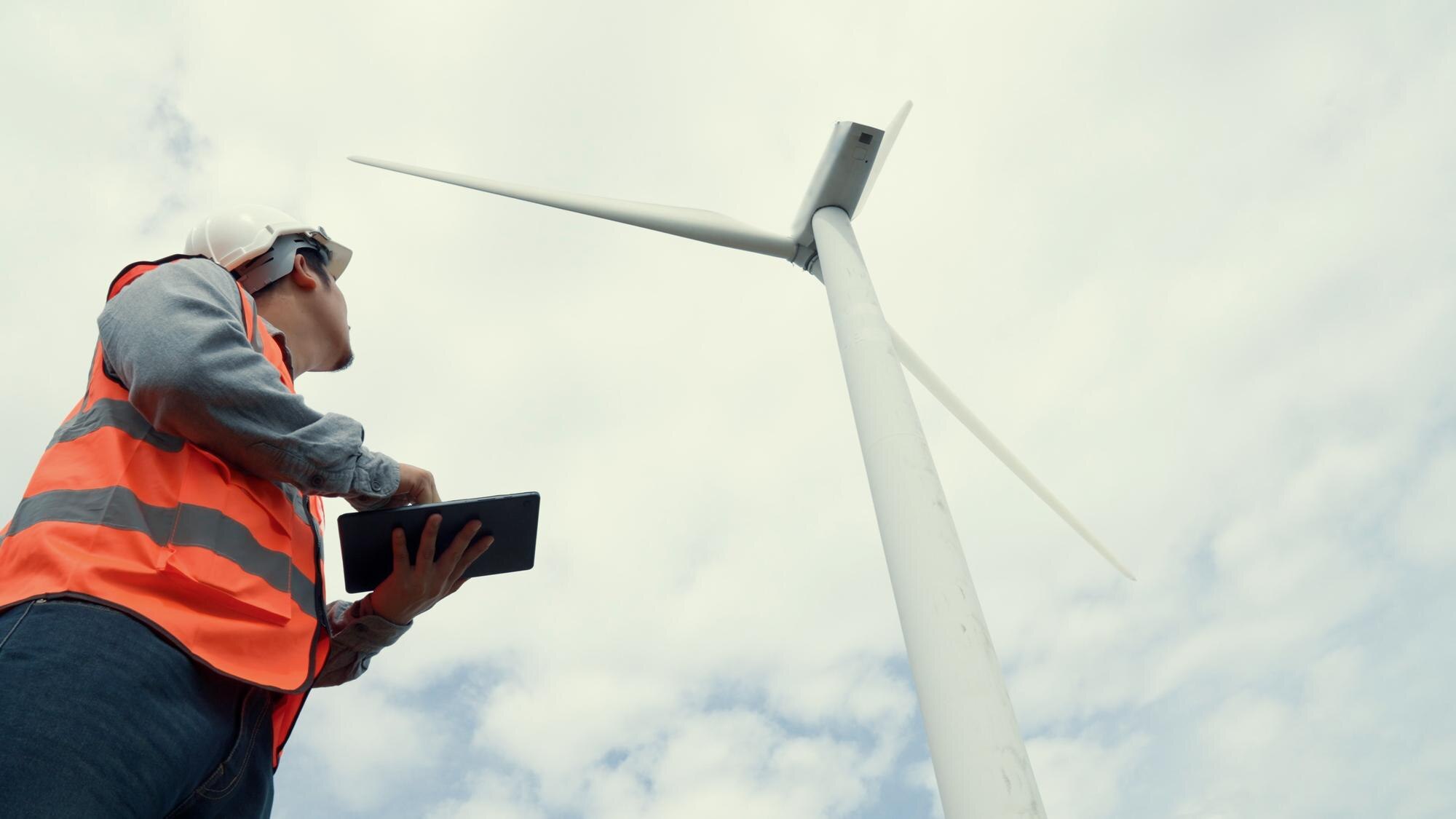Sometimes called wind turbine service technicians or Wind Tech, a wind turbine technician is the first point of contact when a wind turbine begins to experience problems.
Whether you want to become a wind turbine technician and you’re just finishing high school or you already work in the energy sector and want a change, it’s a rewarding career with plenty of opportunities to stay physically active and make a difference.
Let’s dig a little deeper into what is required…
What Does a Wind Turbine Technician Do?
In summary, a wind turbine technician is responsible for installation, maintenance, diagnostic, and repair tasks related to wind turbines.
While engineers work on design and efficiency, anything related to the electrical, mechanical, and hydraulic systems could be serviced by a technician during the course of their daily work.
Daily Responsibilities
As a technician, you’re responsible for duties relating to wind turbines, their upkeep, and making sure safety is maintained onsite. You work closely with engineers to ensure that turbines always operate at a high level.
- Wind Turbine Installations: While not a daily occurrence, wind turbine technicians regularly assist engineers with constructing and installing new turbines on wind farms.
- Inspections and Maintenance: Completing routine inspections where you check for wear and tear, while maintenance includes lubricating mechanical components and replacing any components that have lost their usefulness.
- Troubleshooting and Repairs: Correcting mechanical and electrical issues, which include blades, generators, and all the electrical and mechanical issues.
- Upholding Safety and Compliance: Conduct regular OSHA (Occupational Safety and Health Administration) compliance inspections. Performing emergency shutdowns and reporting any maintenance or safety violations.
These are just some of the tasks that a wind turbine engineer performs on a daily basis, but the actual tasks will vary depending on what wind farms employ you.
Work Environment
A wind turbine technician is a physically demanding position and not a typical office environment.
- Outdoors: Technicians spend most of their time outdoors, often in extreme weather and remote locations where wind farms are frequently built.
- Traveling between sites: Jobs can last for different durations, and you may need to travel between multiple farms as your skills are needed.
- Physical: Working with wind turbines means physical demands, including climbing high elevations multiple times daily.
- Full-time and on-call: Many technicians work regular hours, although you might be required to work weekends extended hours and go out to emergency repairs.
Necessary Skills and Traits for Technicians
These are some of the skills employers look for when hiring entry-level technicians.
Technical Skills
- Ability to read blueprints
- Tool proficiency
- High communication, computer, and reading skills
- Knowledge of electrical, mechanical, and hydraulic systems
- Attention to detail
- Logical mind for troubleshooting
Physical and Personal Traits
- Working at heights of over 300 feet
- Manual dexterity
- Capable of carrying 50 lbs or more
- Good under pressure
- Able to meet the physical demands of the job
- Teamwork
Steps to Become a Wind Turbine Technician
1. Obtain a High School Diploma or GED
Many companies will require at least a year of postsecondary education preferably of a course relating to the job, but first, you should obtain either a high school diploma or a GED.
2. Complete a Wind Turbine Technician Training Program
There are a number of community colleges and trade schools throughout the U.S. and Canada that offer the wind turbine technician training program.
It offers an opportunity to bridge the gap between the educational track in high school and a job by specializing in the skills needed for a career so students can begin a job as a wind turbine technician as soon as they graduate.
The program strengthens math skills and teaches how to apply them while covering the wind turbine’s mechanical, hydraulic, and electrical systems. This includes how to handle repairs and safety issues.
3. Gain Hands-On Experience
Obtaining hands-on experience is a great way to set yourself up for success and to stand out from the rest of the applicants.
A good training program should offer plenty of opportunities for hands-on experience as part of the course while supervised by a qualified person from the industry.
Many programs even offer an internship as a required component of passing the course. These internships or on-the-job training experiences are often completed after the program has ended and can provide experience and a chance to network with future potential employers.
4. Get Industry Certifications
Industry certifications aren’t required to become a Wind Tech. However, they can boost your chances of getting hired.
Global Wind Organization (GWO) offers wind energy-related courses to augment your career. This includes basic and advanced first aid, advanced rescue procedures, blade repair, and working in small space confinement.
The National Fire Protection Association (NFPA) offers the Wind Turbine Technician-I (WTT-I) certification program for technicians who have worked in the profession for at least six months and have a foundational understanding of their role.
To receive the certification, you have to pass an exam. It shows future employers that you have a strong knowledge base, although your hands-on experience is less than others. Many employers hire less experienced technicians that they can train using their company’s procedures.
5. Apply for Entry-Level Jobs
With education and certification completed, the last step is applying for entry-level jobs in your field.
You may have had a chance to network with potential future employers or even taken on an apprenticeship working with a more experienced technician in the field. These are great opportunities to help you stand out from the crowd.
Didn’t you get the chance of moving from one energy job to another? No problem. Focus on your strengths and what you can bring.
Emphasize important skills such as a knowledge of electrical, mechanical, or hydraulic systems that you may have learned from other jobs or your experience working in similar conditions.
Advancement Opportunities for Wind Turbine Technicians
In addition to being a thriving industry that continues to grow, wind energy also offers opportunities for workers to develop and expand their skills.
- Specialization and Additional Training: Certification programs and conferences allow workers who want to branch out to grow their skills. Some employers may pay employees to specialize in one element of repairs, such as electrical systems if they are interested.
- Moving into Supervisory or Managerial Roles: As they gain experience, many technicians move into management positions, supervising a small group of technicians and ensuring timely work completion. A promotion to this level often comes with a pay raise and additional benefits.
- Transitioning to Other Renewable Energy Careers: There is an overlap in skills between sectors of the renewable energy industry. After gaining experience in wind energy, there are opportunities to transition to solar or hydroelectric power as a renewable energy technician.
Pros and Cons of Wind Turbine Technicians
Being a wind turbine technician offers pros and cons, just like any profession. Consider these when you’re deciding whether or not you want to pursue a career in the industry.
Pros
- Environmentally conscious: You become involved in the renewable energy sector. Wind energy is a safe, clean, and growing industry that is helping to replace fossil fuels.
- Outdoor work environment: While not for everyone, becoming a wind turbine technician does allow you to work outdoors away from stuffy office environments.
- Hands-on work: What you do will have a tangible effect. You will be making a difference in your job that will be the result of practical, hands-on work.
- Minimal education requirements: Many technicians obtain an apprenticeship or entry-level position with a high school diploma or GED. Those seeking more hands-on experience often complete a 1–2 year program, much shorter than an engineering degree.
Cons
- Physically demanding: The job requires heavy lifting and climbing in remote locations that often experience extreme weather conditions.
- Risks at work: Safety is extremely important in this career, but there are still risks associated with working at great heights with high voltage.
- Relocation: Companies sometimes require technicians to live close to the wind farms they work at, which may require relocation from a city to a more rural location.
- Work environment: While it may be a pro for some people, others may find working outdoors in all weather conditions to be stressful and unpleasant.
Final Thoughts: Is This Career Right for You?
The renewable energy sector is growing, and the belief is that jobs in wind, solar, and hydroelectric energy will continue to be created daily. As fossil fuels are phased out or replaced in part with these green sources, this is only going to increase.
A career as a wind turbine technician isn’t for everyone, but if you want an energy job outdoors that is physically active and prioritizes hands-on work, it may be for you.
Look into job listings close to you and see if your skills are transferable or what skills will be needed to get the energy job of your dreams.









